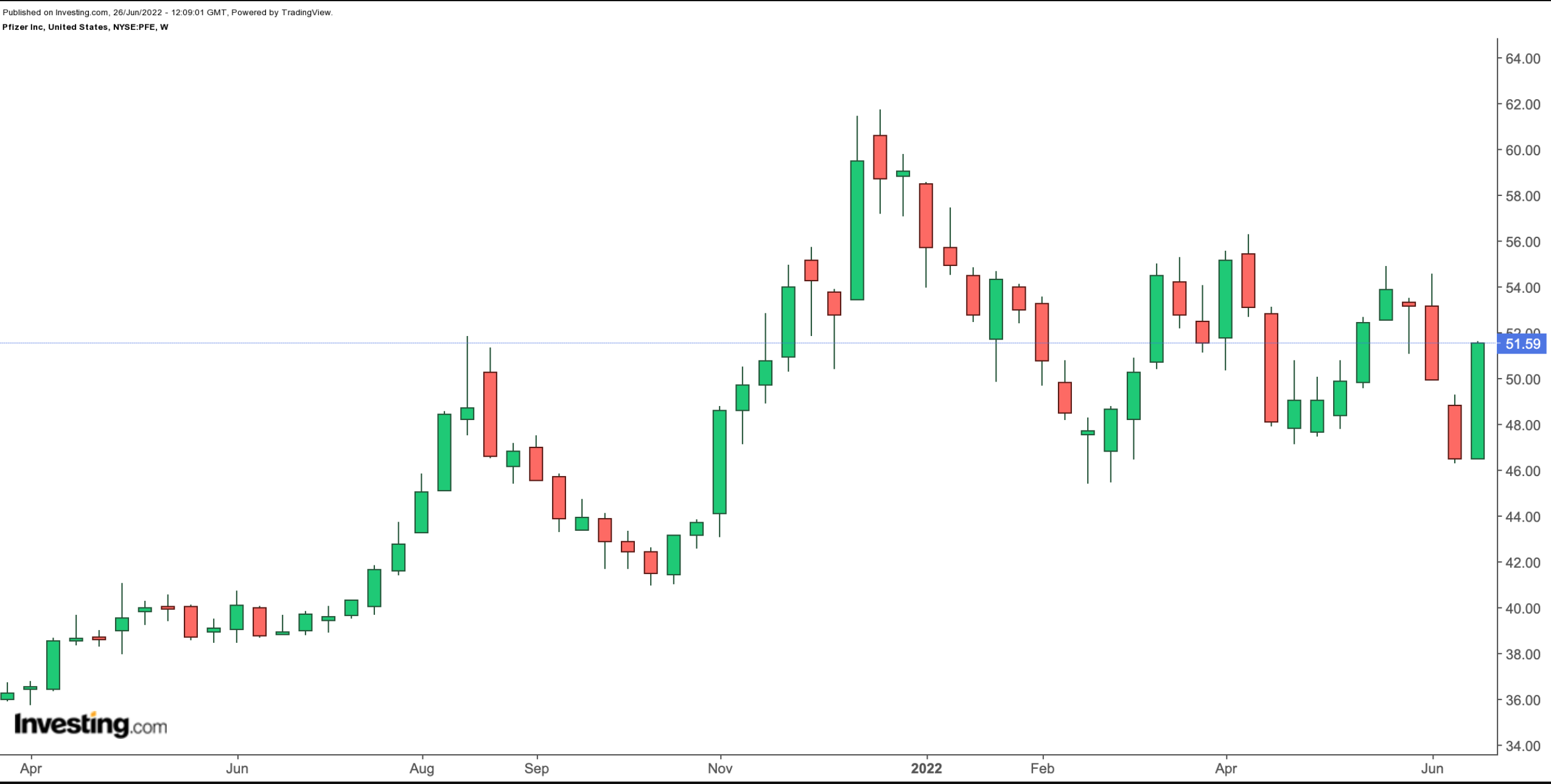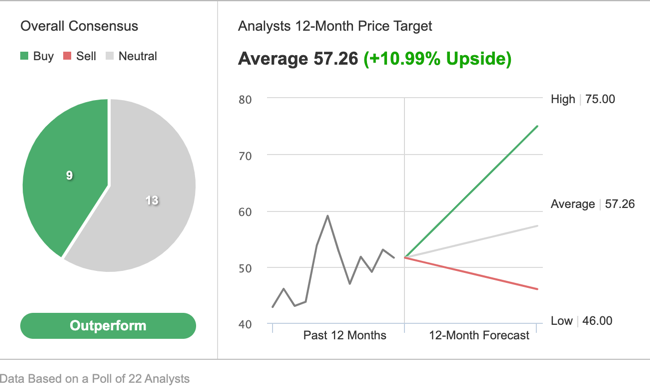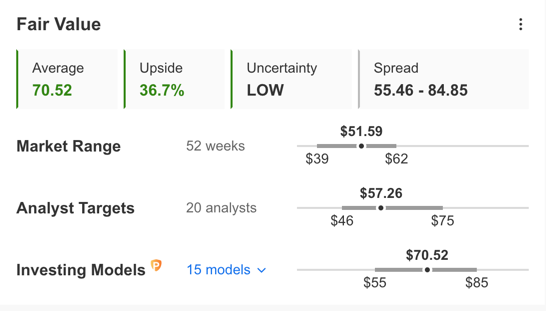- Shares of Pfizer are down over 12.5% since the start of 2022.
- Plan to spend cash generated from COVID-19 vaccine on M&As and share buybacks.
- Long-term investors may consider buying PFE stock at current levels.
- Looking for more top-rated stock ideas to add to your portfolio? Members of InvestingPro+ get exclusive access to our research tools, data, and pre-selected screeners. Learn More »
Shareholders in Pfizer (NYSE:PFE) stock have seen the value of their investment increase over 32% in the past 52 weeks. However, PFE shares have declined 12.5% year-to-date (YTD).
By comparison, the Dow Jones Health Care is down roughly 10% in 2022. Meanwhile, two other major pharma shares, Eli Lilly (NYSE:LLY) and Merck (NYSE:MRK), have gained 17.9% and 21.5%, respectively.

On Dec. 20, 2021, PFE shares went over $61, hitting a record high. The stock’s 52-week range has been $38.82-$61.71. The market capitalization (cap) currently stands at $289.5 billion.
How Recent Metrics Came
Pfizer released Q1 figures on May 3. Revenue totaled $25.7 billion, up 77% year-over-year (YoY). Adjusted net income was $9.3 billion, or $1.62 per diluted share, compared to an adjusted net income of $5.4 billion, or 95 cents per diluted share, a year ago.
Given its leading position in the coronavirus vaccine market, Pfizer is generating significant cash. Revenue and earnings have increased, thanks to Comirnaty, the COVID-19 vaccine offered jointly with BioNTech (NASDAQ:BNTX).
In December 2021, the US Food and Drug Administration (FDA) also authorized Paxlovid “for the treatment of mild-to-moderate COVID-19.” The healthcare giant generated $31.78 billion in free cash flow during the first quarter, representing a 50% increase YoY.
On the results, chief financial officer Frank D’Amelio commented:
“We entered the open market to repurchase shares of our stock for the first time since 2019. We will continue to thoughtfully deploy our capital in a variety of shareholder-friendly ways with the goal of maximizing the value we provide to all of our stakeholders, including patients and shareholders.”
Pfizer has recently ramped up its M&A activity, fueled by its growing pile of cash. For example, in March it bought Arena Pharmaceuticals for $6.7 billion in cash. This transaction adds a number of pipeline candidates that target immuno-inflammatory diseases.
Then, in early June, Pfizer also completed the acquisition of ReViral, a privately held clinical-stage biopharmaceutical company focused on therapies for the respiratory syncytial virus. While Pfizer currently relies on its coronavirus portfolio for growth, these new names are primed to boost long-term growth.
After the release of Q1 results, Pfizer kept its previous revenue guidance unchanged within the $98-$102 billion range. On the other hand, diluted EPS guidance was revised down from the previous $6.35-$6.55 range to $6.25-$6.45.
Prior to the release of the Q1 results, PFE stock was around $49.00. On June 24, it closed at $51.59, and offers a dividend yield of 3.1%.
What To Expect From Pfizer Stock
PFE stock has an "outperform" rating among 22 analysts polled via Investing.com. Wall Street has a 12-month median price target of $57.26 for the stock, an increase of 11% from the current price. The 12-month price range currently stands between $46 and $75.
Source: Investing.com
Similarly, according to a number of valuation models including P/E or P/S multiples or terminal values, the average fair value for PFE stock on InvestingPro stands at $70.52.

Source: InvestingPro
So fundamental valuation suggests shares could increase 36.7%.
Examining PFE’s financial health in terms of growth, price momentum, and profit, it scores 4 out of 5. Its overall score of 4 points is a great performance ranking.
At present, PFE’s P/E, P/B and P/S ratios are 11.4x, 3.5x and 3.1x, respectively compared to 17.7x, 4.9x and 3.9x respectively for peers which suggest that fundamentally it looks undervalued compared to healthcare peers.
We expect PFE stock to build a base between $48 and $53 in the coming weeks and then potentially start a new leg up.
Adding PFE Stock To Portfolios
Pfizer bulls who are not concerned about short-term volatility could consider investing now with a target of $57.26, as per Wall Street analysts.
Alternatively, investors could consider buying an exchange-traded fund (ETF) that has PFE stock as a holding. Examples include:
- iShares U.S. Pharmaceuticals ETF (NYSE:IHE)
- First Trust Morningstar Dividend Leaders Index Fund (NYSE:FDL)
- Health Care Select Sector SPDR® Fund (NYSE:XLV)
- Vanguard S&P 500 ETF (NYSE:VOO)
- ETC 6 Meridian Hedged Equity-Index Option Strategy ETF (NYSE:SIXH)
Finally, those experienced with options could also consider selling a cash-secured put option in PFE stock—a strategy we regularly cover. Such a bullish trade could especially appeal to those who want to receive premiums (from put selling) or to possibly own PFE shares for less than their current market price of $51.59.
Most option strategies are not suitable for all retail investors. Therefore, the following discussion on PFE stock is offered for educational purposes and not as an actual strategy to be followed by the average retail investor.
So the trader would typically write an at-the-money (ATM) or an out-of-the-money (OTM) put option and simultaneously set aside enough cash to buy 100 shares of the stock.
Let's assume the trader is putting on this trade until the option expiry date of August 19. As the stock is $51.45 at time of writing, an OTM put option would have a strike of $50.00. This put option is currently offered at a price (or premium) of $1.85.
An option buyer would have to pay $1.85 X 100, or $185, in premium to the option seller. This premium amount belongs to the option seller no matter what happens in the future and also it is the seller’s maximum gain. The put option will stop trading on Friday, August 19.
If the put option is in the money (meaning the market price of PFE stock is lower than the strike price of $50.00) any time before or at expiration on Aug. 19, this put option can be assigned. The seller would then be obligated to buy 100 shares of PFE stock at the put option's strike price of $50.00 (i.e. at a total of $4,750).
The break-even point for our example is the strike price ($50.00) less the option premium received ($1.85), i.e., $48.15. This is the price at which the seller would start to incur a loss.
Bottom Line
Cash-secured put selling is a moderately more conservative strategy than buying shares outright at the current market price. It could be a way to capitalize on the choppiness in PFE stock in the coming weeks.
Investors who end up owning Pfizer as a result of selling puts could further consider setting up covered calls to increase the potential returns on their shares. Thus, selling cash-secured puts could be regarded as the first step in PFE stock ownership.
***
The current market makes it harder than ever to make the right decisions. Think about the challenges:
- Inflation
- Geopolitical turmoil
- Disruptive technologies
- Interest rate hikes
To handle them, you need good data, effective tools to sort through the data, and insights into what it all means. You need to take emotion out of investing and focus on the fundamentals.
For that, there’s InvestingPro+, with all the professional data and tools you need to make better investing decisions. Learn More »
